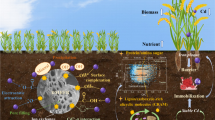Abstract
Remediation of cadmium (Cd) from contaminated soils is considered a complicated task of environmental safety. A column leaching experiment was planned to estimate the influence of biochar (BC), zeolite (ZE) and steel slag (SL) at 1.5% and 3% application rate on Cd leaching behavior and chemical fractionation in contaminated soil. A sequential extraction procedure, the European Community Bureau of Reference (BCR), Toxicity Characteristic Leaching Procedure (TCLP) and NH4NO3 were performed after leaching was completed. The soluble portion of Cd was decreased by 36.3%, 18.4% and 28.7% and Cd contents in leachate were decreased by 44.8%, 30% and 31.3% after BC, ZE and SL addition at 3% rate, respectively over control soil. The greater reduction in TCLP extractable Cd was observed by 29.6% with BC and 22.4% with ZE and 25.7% with SL at 3% application rate. Overall, biochar can be considered an efficient soil amendment to reduce Cd leaching as well as increased its stabilization within soil profile.






Similar content being viewed by others
References
Ahmad M, Rajapaksha AU, Lim JE, Zhang M, Bolan N, Mohan D, Vithanage M, Lee SS, Ok YS (2014) Biochar as a sorbent for contaminant management in soil and water: a review. Chemosphere 99:19–33
Bashir S, Salam A, Chhajro MA, Fu Q, Khan MJ, Zhu J, Shaaban M, Kubar KA, Ali U, Hu H (2018a) Comparative efficiency of rice husk-derived biochar (RHB) and steel slag (SS) on cadmium (Cd) mobility and its uptake by Chinese cabbage in highly contaminated soil. Int J Phytorem. https://doi.org/10.1080/15226514.2018.1448364
Bashir S, Rizwan MS, Salam A, Fu Q, Zhu J, Shaaban M, Hu H (2018b) Cadmium immobilization potential of rice straw-derived biochar, zeolite and rock phosphate: extraction techniques and adsorption mechanism. Bull Environ Contam Toxicol. https://doi.org/10.1007/s00128-018-2310-z
Bashir S, Shaaban M, Mehmood S, Zhu J, Fu Q, Hu H (2018c) Efficiency of C3 and C4 plant derived-biochar for Cd mobility, nutrient cycling and microbial biomass in contaminated soil. Bull Environ Contam Toxicol. https://doi.org/10.1007/s00128-018-2332-6
Bing HY, Dao-You H, Qi-Hong Z, Shuai W, Shou-Long L, Hai-Bo H, Han-Hua Z, Chao X (2017) A three-season field study on the in-situ remediation of Cd-contaminated paddy soil using lime, two industrial by-products, and a low-Cd accumulation rice cultivar. Ecotox Environ Safe 136:135–141
Lu RK (2000) Methods of inorganic pollutants analysis. In: Soil and agro-chemical analysis methods. Agricultural Science and Technology Press, Beijing, pp 205–266
Lu K, Yang X, Shen J, Robinson B, Huang H, Liu D, Bolan N, Pei J, Wang H (2014) Effect of bamboo and rice straw biochars on the bioavailability of Cd, Cu, Pb and Zn to Sedum plumbizincicola. Agric Ecosys Environ 191:124–132
Mehmood S, Rizwan M, Bashir S, Ditta A, Aziz O, Yong LZ, Dai Z, Akmal M, Ahmed W, Adeel M, Imtiaz M, Tu S (2017) Comparative effects of biochar, slag and ferrous-Mn ore on lead and cadmium immobilization in soil. Bull Environ Contam Toxicol. https://doi.org/10.1007/s00128-017-2222-3
Mohamed I, Zhang G, Li Z, Liu Y, Chen F, Dai K (2015) Ecological restoration of an acidic Cd contaminated soil using bamboo biochar application. Ecol Eng 84:67–76
Ning S, Liang Y, Song A, Duan A, Liu Z (2016) In situ stabilization of heavy metals in multiple-metal contaminated paddy soil using different steel slag-based silicon fertilizer. Environ Sci Pollut Res 23:23638–23647
Oste LA, Lexmond TM, Van Riemsdijk WH (2002) Metal immobilization in soils using synthetic zeolites. J Environ Qual 31:813–821
Rauret G, Lopez-Sanchez JF, Sahuquillo A, Rubio R, Davidson C, Ure A, Quevauviller P (1999) Improvement of the BCR three step sequential extraction procedure prior to the certification of new sediment and soil reference materials. J Environ Monitor 1:57–61
Schlichting E, Blume HP, Stahr K (1995) Bodenkundliches Parktikum. Blackwell, Berlin
Song WM, Chen BM, Lu L (2013) Soil heavy metal pollution of cultivated land in China. Res Soil Water Conserv 20:293–298
USEPA (1992) EPA method 1311. TCLP-toxicity characteristic leaching procedure. In: Test methods for evaluating solid waste, 3rd edn. Environmental Protection Agency, Washington
Wen J, Yi Y, Zeng G (2016) Effects of modified zeolite on the removal and stabilization of heavy metals in contaminated lake sediment using BCR sequential extraction. J Environ Manage 178:63–69
Yuan JH, Xu RK, Zhang H (2011) The forms of alkalis in the biochar produced from crop residues at different temperatures. Bioresour Technol 102:3488–3497
Author information
Authors and Affiliations
Corresponding authors
Rights and permissions
About this article
Cite this article
Bashir, S., Salam, A., Rehman, M. et al. Effective Role of Biochar, Zeolite and Steel Slag on Leaching Behavior of Cd and Its Fractionations in Soil Column Study. Bull Environ Contam Toxicol 102, 567–572 (2019). https://doi.org/10.1007/s00128-019-02573-6
Received:
Accepted:
Published:
Issue Date:
DOI: https://doi.org/10.1007/s00128-019-02573-6




